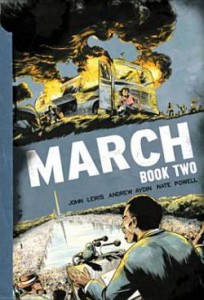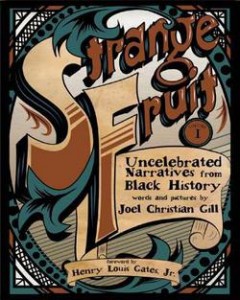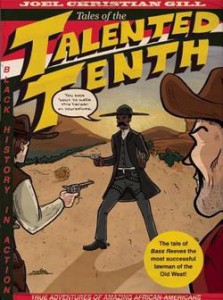2018 School Spending Survey Report
Sound and Fury | Graphic Nonfiction for Teens
Visually enticing, featuring dramatic colors or memorable images, graphic nonfiction is a surefire hit in high school collections. And what better way to transform students' conception of history from a compilation of long-ago events and obscure names into real people, with relatable stories?
 Though books covering the civil rights movement are legion, John Lewis and Andrew Aydin’s latest volume in the “March” series, March: Book Two (Top Shelf Productions, 2015; Gr 8 Up), is a must-have title. U.S. Representative and activist Lewis pulls back a curtain, providing readers with an intimate, firsthand glimpse at his experiences confronting the injustices of segregation, as a Freedom Rider, the chairman of the Student Nonviolent Coordinating Committee, and one of the planners of the historic 1963 March on Washington. It's far from the neatly packaged view of history, full of solemn black-and-white images of now-revered leaders, archival footage of fervent speeches, and sound bites, typically presented to young people. Lewis’s portrayal is messier but nuanced, depicting the conflicts that erupted between civil rights leaders and Washington politicians, as well as among the activists themselves, all of whom wanted equality but disagreed—often strenuously—on the best way to achieve it. Nate Powell’s evocative black-and-white illustrations transform the images of Martin Luther King Jr., James Fox, Diane Nash, and Lewis himself from austere, almost untouchable figures into courageous rebels. Powell masterfully portrays the expressions of this cast of characters, from the stone-faced masks of anger and indifference of those who favored segregation to the steely eyed determination with which Lewis and his colleagues armed themselves. Marked by the pain and violence of this period, March effectively conveys the uncertainty that Lewis and others felt in the face of opposition. Infused with sound and fury, this is a powerfully triumphant work that shows the movement not as a quietly dignified affair but a living, breathing thing—turbulent, even troubled, but truly moving.
Though books covering the civil rights movement are legion, John Lewis and Andrew Aydin’s latest volume in the “March” series, March: Book Two (Top Shelf Productions, 2015; Gr 8 Up), is a must-have title. U.S. Representative and activist Lewis pulls back a curtain, providing readers with an intimate, firsthand glimpse at his experiences confronting the injustices of segregation, as a Freedom Rider, the chairman of the Student Nonviolent Coordinating Committee, and one of the planners of the historic 1963 March on Washington. It's far from the neatly packaged view of history, full of solemn black-and-white images of now-revered leaders, archival footage of fervent speeches, and sound bites, typically presented to young people. Lewis’s portrayal is messier but nuanced, depicting the conflicts that erupted between civil rights leaders and Washington politicians, as well as among the activists themselves, all of whom wanted equality but disagreed—often strenuously—on the best way to achieve it. Nate Powell’s evocative black-and-white illustrations transform the images of Martin Luther King Jr., James Fox, Diane Nash, and Lewis himself from austere, almost untouchable figures into courageous rebels. Powell masterfully portrays the expressions of this cast of characters, from the stone-faced masks of anger and indifference of those who favored segregation to the steely eyed determination with which Lewis and his colleagues armed themselves. Marked by the pain and violence of this period, March effectively conveys the uncertainty that Lewis and others felt in the face of opposition. Infused with sound and fury, this is a powerfully triumphant work that shows the movement not as a quietly dignified affair but a living, breathing thing—turbulent, even troubled, but truly moving.  Though Joel Christian Gill’s Strange Fruit Volume I: Uncelebrated Narratives from Black History (Fulcrum, 2014; Gr 8 Up) is inspired by the song popularized by Billie Holiday decrying lynching in the South, this work is no lament but rather a rich celebration that, in the author’s words, “tells stories of people who, in spite of the ‘Strange Fruit’ society where they lived, liberated themselves from the magnolia trees and tried to do something amazing.” Forgoing the sepia-toned images of Frederick Douglass, Harriet Tubman, or George Washington Carver that readers are familiar with, Gill offers tales of unsung individuals and places, such as Harry “Bucky” Lew, the first black basketball player and Spottswood Rice, a black soldier who during the Civil War penned two letters declaring his intention to reclaim his enslaved children. The tales vary in subject matter and in tone, from the heartbreaking to the triumphant to the eccentric, but a strong dash of humor and whimsy permeates the compilation. The cartoon artwork, full of action and bright colors, is ideal for a young audience, and though there are some tough subjects here, they’re covered in a way that won’t deter even sensitive readers. Gill’s inspired storytelling and artistic devices are what really set the book apart; creative and thought-provoking, though never heavy-handed, they push students to consider racism and bigotry while never detracting from the narrative. His tale of Theophilus Thompson, an enslaved man who becomes a skilled chess player, opens with an explanation that the game can be seen as a metaphor for the inherently unequal status of African Americans (those playing “black” must go second, representing a built-in disadvantage), while his story of Marshall “Major” Taylor, a cyclist born in 1878, depicts the athlete racing against a large, imposing black bird with red eyes: Jim Crow. Gill has a unique and visionary way of capturing history; Strange Fruit is an unforgettable work that should be a part of every history collection.
Though Joel Christian Gill’s Strange Fruit Volume I: Uncelebrated Narratives from Black History (Fulcrum, 2014; Gr 8 Up) is inspired by the song popularized by Billie Holiday decrying lynching in the South, this work is no lament but rather a rich celebration that, in the author’s words, “tells stories of people who, in spite of the ‘Strange Fruit’ society where they lived, liberated themselves from the magnolia trees and tried to do something amazing.” Forgoing the sepia-toned images of Frederick Douglass, Harriet Tubman, or George Washington Carver that readers are familiar with, Gill offers tales of unsung individuals and places, such as Harry “Bucky” Lew, the first black basketball player and Spottswood Rice, a black soldier who during the Civil War penned two letters declaring his intention to reclaim his enslaved children. The tales vary in subject matter and in tone, from the heartbreaking to the triumphant to the eccentric, but a strong dash of humor and whimsy permeates the compilation. The cartoon artwork, full of action and bright colors, is ideal for a young audience, and though there are some tough subjects here, they’re covered in a way that won’t deter even sensitive readers. Gill’s inspired storytelling and artistic devices are what really set the book apart; creative and thought-provoking, though never heavy-handed, they push students to consider racism and bigotry while never detracting from the narrative. His tale of Theophilus Thompson, an enslaved man who becomes a skilled chess player, opens with an explanation that the game can be seen as a metaphor for the inherently unequal status of African Americans (those playing “black” must go second, representing a built-in disadvantage), while his story of Marshall “Major” Taylor, a cyclist born in 1878, depicts the athlete racing against a large, imposing black bird with red eyes: Jim Crow. Gill has a unique and visionary way of capturing history; Strange Fruit is an unforgettable work that should be a part of every history collection.  With Bass Reeves: Tales of the Talented Tenth Volume 1 (Fulcrum, 2014; Gr 7 Up), Gill expands upon a brief chapter from Strange Fruit, devoting a full-length book to Reeves. Born into slavery in 1838, Reeves was taught as a young boy how to shoot by his master but upon growing to maturity fled to live among the Cherokee, Seminole, and Creek. His experiences and sharpshooting skills made him ideal as a U.S. Deputy Marshall, and he began working west of the Mississippi, eventually capturing more than 3,000 outlaws—including his own son. Part of Gill’s “Talented Tenth” series, devoted to celebrating noteworthy African Americans, the book's cover features a gruff-looking Reeves brandishing a pistol in each hand: an image reminiscent of Spaghetti Westerns, pulp fiction, and 1950s-style comics. Reeves’s story—thought to have inspired the Lone Ranger and Quentin Tarantino’s Django Unchained—will be an easy sell for students more likely to pick up a superhero comic than a historical biography. While Reeves worked on the right side of the law, Gill makes it clear that the man was an outsider in a flawed society, adhering to his own moral compass and sense of justice. As with Strange Fruit, the illustrations are cartoonlike and exaggerated and with a minimum of text, and Gill folds in some important themes and lessons. His use of symbols to indicate when speakers are using racial slurs, for instance, conveys Reeves’s growing rage and frustration with the bigotry around him. Equal parts adventure and historical account, this stirring and original title will appeal to a broad range of readers.
With Bass Reeves: Tales of the Talented Tenth Volume 1 (Fulcrum, 2014; Gr 7 Up), Gill expands upon a brief chapter from Strange Fruit, devoting a full-length book to Reeves. Born into slavery in 1838, Reeves was taught as a young boy how to shoot by his master but upon growing to maturity fled to live among the Cherokee, Seminole, and Creek. His experiences and sharpshooting skills made him ideal as a U.S. Deputy Marshall, and he began working west of the Mississippi, eventually capturing more than 3,000 outlaws—including his own son. Part of Gill’s “Talented Tenth” series, devoted to celebrating noteworthy African Americans, the book's cover features a gruff-looking Reeves brandishing a pistol in each hand: an image reminiscent of Spaghetti Westerns, pulp fiction, and 1950s-style comics. Reeves’s story—thought to have inspired the Lone Ranger and Quentin Tarantino’s Django Unchained—will be an easy sell for students more likely to pick up a superhero comic than a historical biography. While Reeves worked on the right side of the law, Gill makes it clear that the man was an outsider in a flawed society, adhering to his own moral compass and sense of justice. As with Strange Fruit, the illustrations are cartoonlike and exaggerated and with a minimum of text, and Gill folds in some important themes and lessons. His use of symbols to indicate when speakers are using racial slurs, for instance, conveys Reeves’s growing rage and frustration with the bigotry around him. Equal parts adventure and historical account, this stirring and original title will appeal to a broad range of readers. RELATED
RECOMMENDED
CAREERS
The job outlook in 2030: Librarians will be in demand
CAREERS
The job outlook in 2030: Librarians will be in demand
ALREADY A SUBSCRIBER? LOG IN
We are currently offering this content for free. Sign up now to activate your personal profile, where you can save articles for future viewing






Add Comment :-
Be the first reader to comment.
Comment Policy:
Comment should not be empty !!!